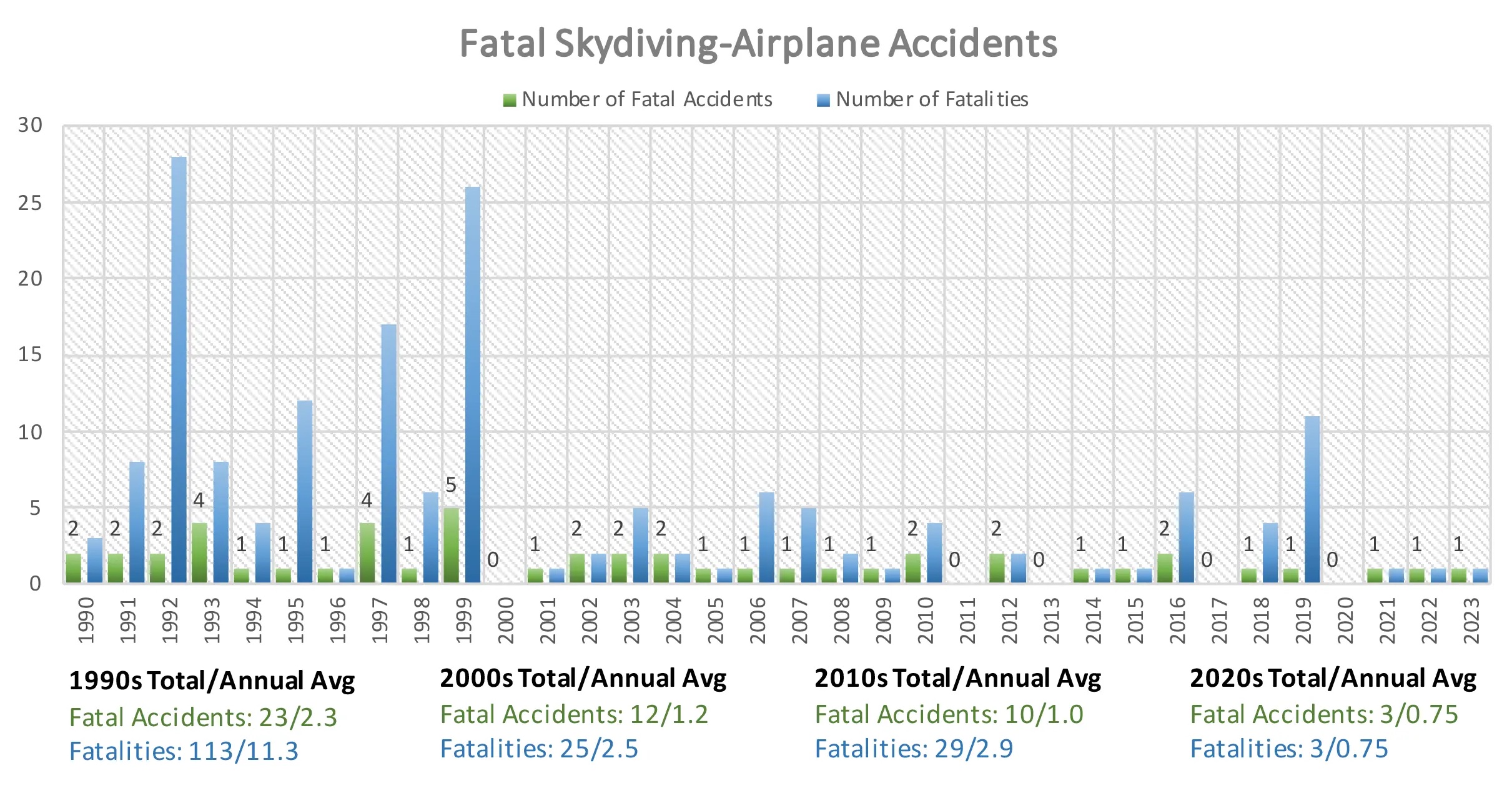How safe is skydiving?
Like any outdoor sport, skydiving involves inherent risk but proper preparation and good judgment can minimize the vast majority of them. Many think that equipment failure causes most skydiving accidents, but the reality is that the vast majority are a result of simple human error. Many of the accidents occur because the jumper—oftentimes an experienced skydiver who is pushing the limits— makes an error in judgement while landing a perfectly functioning parachute. (Just as automobile accidents are not usually the result of equipment failure, but rather operator mistakes.)
Skydiving Statistics
The following report is based on the 2024 USPA Member Survey that asked skydivers about their skydiving data from the year, such as total jumps, injuries and use of an emergency backup parachute (reserve). According to this survey, USPA Members made slightly more jumps in the U.S. in 2024 than in 2023 with an estimated 3,880,000 skydives made.
Equipment Safety
Each parachute system is equipped with a main and reserve parachute, and all student systems include an automatic activation device, which is an electric device that will release the reserve if the main parachute does not deploy. At least 90% of experienced skydivers also equip themselves with this device. Although no equipment can be perfect, modern parachute equipment incorporates advanced safety features and undergoes testing in conditions that far exceed the stresses it will endure on a normal jump. Statistically, accidents involving equipment malfunctions are the result of the skydiver reacting incorrectly and not following the prescribed emergency procedures.
Reserve Rides
In 2024, 12.3% of USPA members reported using their reserve parachute. Some reported more than one reserve use, bringing the estimated total to 5,080 reserve rides, or an estimated 1 reserve use per 764 jumps.
Injuries
5.6% of members reported that they experienced an injury that required medical treatment in 2024, the most common being ankle injuries from landings.
Fatalities
In 2024, USPA members reported making 3.88 million skydives. In the same year, there were a total of 9 civilian skydiving fatalities in the United States. This is a record low number since record keeping began in 1961. Back then, there were 14 fatalities while the level of skydiving activity was a tiny fraction of what it is today. The annual number of fatalities peaked in the late 1970’s before beginning a slow decline. While the fatality numbers decreased over the years, the activity level of skydiving increased significantly. When the numbers are placed into a rate index, (0.23 deaths per 100,000 jumps) it is easy to see just how much progress has been made in reducing the risks of making a skydive.
| Year |
Skydiving Fatalities in U.S. |
Estimated Annual Jumps |
Fatalities Per 100,000 Jumps |
| 2024 |
9 |
3.88 million |
0.23 |
| 2023 |
10 |
3.65 million |
0.27 |
| 2022 |
20 |
3.9 million |
0.51 |
| 2021 |
10 |
3.57 million |
0.28 |
| 2020 |
11 |
2.8 million |
0.39 |
| 2019 |
15 |
3.3 million |
0.45 |
| 2018 |
13 |
3.3 million |
0.39 |
| 2017 |
24 |
3.2 million |
0.75 |
| 2016 |
21 |
3.2 million |
0.66 |
| 2015 |
21 |
3.5 million |
0.60 |
| 2014 |
24 |
3.2 million |
0.75 |
| 2013 |
24 |
3.2 million |
0.75 |
| 2012 |
19 |
3.1 million |
0.61 |
| 2011 |
25 |
3.1 million |
0.81 |
| 2010 |
21 |
3.0 million |
0.70 |
| 2009 |
16 |
3.0 million |
0.53 |
| 2008 |
30 |
2.6 million |
1.15 |
| 2007 |
18 |
2.5 million |
0.72 |
| 2006 |
21 |
2.5 million |
0.84 |
| 2005 |
27 |
2.6 million |
1.04 |
| 2004 |
21 |
2.6 million |
0.81 |
What about jumping out of a “perfectly good” skydiving aircraft?
Skydiving operations have a much lower aircraft accident rate than general aviation. Skydive jump pilots receive thorough training prior to flying skydivers and that training must include aircraft-specific systems, preflight inspections, weight and balance considerations and proper fuel management. Skydivers receive instruction on how to respond to aircraft emergencies during their initial student training, and most skydiving centers reinforce this training at various times of the year. In the past 10 years, there have been eight fatal aircraft accidents related to skydiving with 25 total fatalities.

Safe Skydiving Centers
As an organization, we look at individual accidents—whether fatal or not—to see what we can learn to make the sport safer. We do not count deaths by state, region or facility, since that is usually not a factor. (The number of skydiving accidents at a skydiving business is typically proportional to the volume of skydives they conduct) All USPA Group Member drop zones have made a pledge to use appropriately rated instructors, equipment and pilots.
More Information
Each April, USPA publishes an in-depth report on skydiving incidents and skydiving-related aircraft incidents in Parachutist magazine, which are available under the Back-Issues tab at Parachutist.com